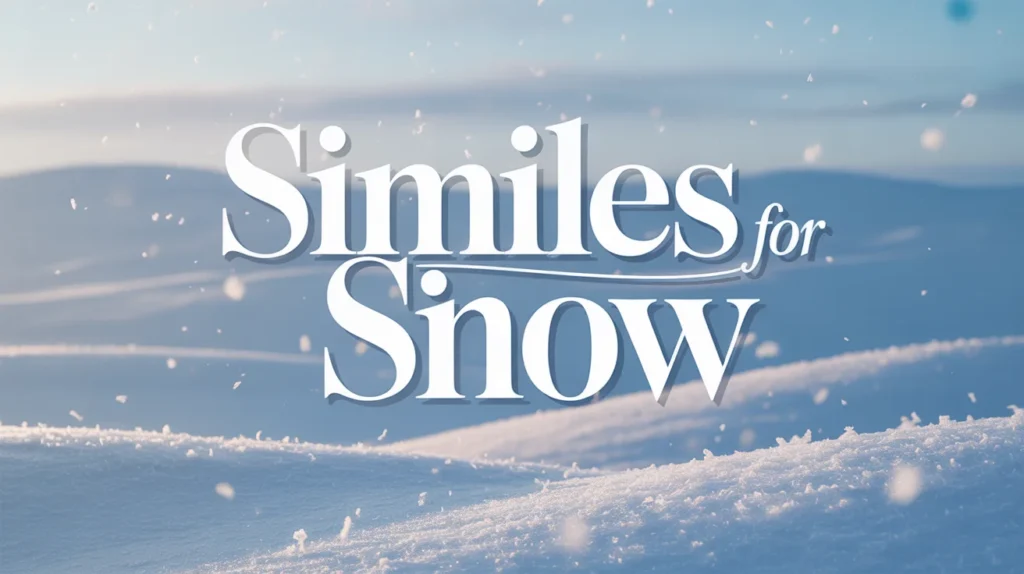Snow has always fascinated poets, writers, and dreamers alike. Its quiet descent turns cities into wonderlands, mountains into silver giants, and ordinary days into scenes from a fairy tale. But when it comes to describing snow in writing, similes for snow become one of the most powerful tools.
A simile, a literary device comparing two different things using “like” or “as”, can transform plain descriptions into vivid, emotional imagery.
In this article, we’ll explore creative, poetic, and meaningful similes for snow — from the soft and delicate to the cold and harsh. Whether you’re a writer, student, or content creator, these examples will help you capture the essence of snow in all its moods.
Understanding Similes The Art Behind Snow Descriptions
Before diving into specific examples, let’s first understand why similes work so beautifully with snow.
Snow is more than frozen water — it’s a sensory experience. It looks soft, feels cold, and sounds silent. Similes allow you to express those sensations through relatable imagery.
For example:
- “The snow was as white as milk.”
- “Snowflakes fell like feathers from the sky.”
Both sentences paint mental pictures that readers can instantly visualize. They add depth, personality, and emotion to an otherwise plain description.
Why Use Similes for Snow in Writing
Using similes for snow enhances your writing in multiple ways:
BenefitDescriptionCreates vivid imageryHelps readers see, feel, and hear the snow.Adds emotional depthSnow can symbolize purity, silence, sadness, or peace.Improves engagementDescriptive language keeps readers hooked.Boosts creativityEncourages original thinking and expression.SEO advantage (for content writers)Keywords like “similes for snow,” “snow imagery,” and “snow metaphors” can attract organic traffic from literature and education searches.
In short, similes breathe life into your winter descriptions, turning simple sentences into sensory experiences.
Common and Classic Similes for Snow
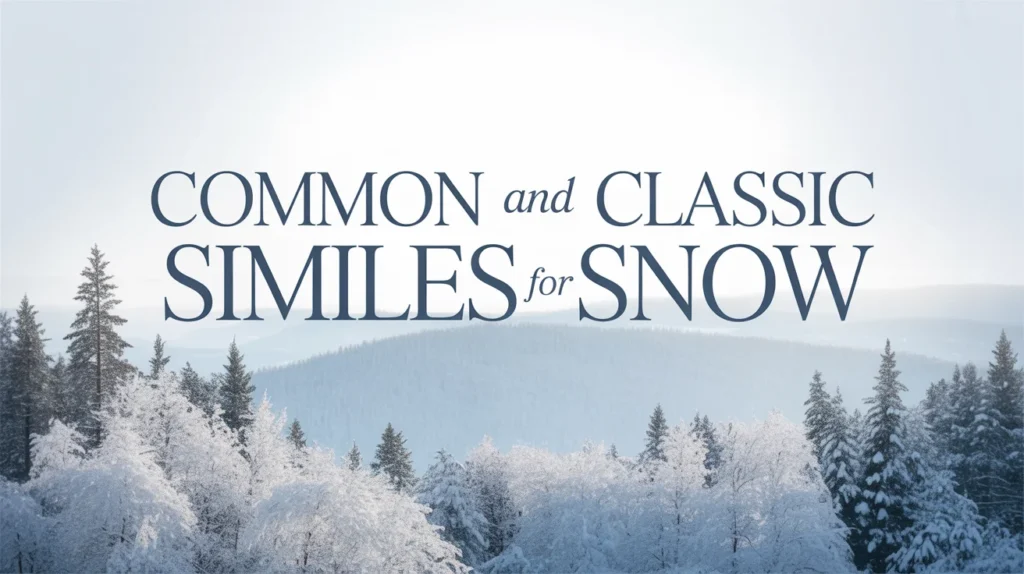
Let’s start with some of the most timeless and recognizable similes used by poets and writers across the world. These examples are perfect for essays, poems, or storytelling.
1. As White as Snow
One of the most common similes, symbolizing purity, innocence, and freshness.
- “Her skin was as white as snow.”
- “The fields were blanketed, white as snow under the morning sun.”
2. Like Feathers Falling
Evokes softness and gentleness.
- “The snowflakes drifted down like feathers from an angel’s wings.” This simile creates a feeling of grace and calmness.
3. As Cold as Ice
While not exclusive to snow, it captures the chill and harshness of winter.
- “His hands were as cold as ice after walking in the snowstorm.”
4. Like Cotton or Wool
Describes texture and fluffiness.
- “The snow was piled up like soft cotton on the ground.”
5. As Soft as a Whisper
Highlights the silence and serenity of snowfall.
- “The snow fell as soft as a whisper, blanketing the world in quiet.”
Creative Similes for Snow (Original Examples)
For a truly premium, unique, and SEO-optimized experience, let’s explore original similes for snow that go beyond clichés. These are crafted for creative writers who want their words to stand out.
SimileMeaning & EffectSnow fell like silver dust from heaven.Suggests elegance and purity.As fleeting as snow on warm hands.Reflects impermanence or lost moments.Snow sparkled like shattered glass under the sun.Contrasts beauty and fragility.As gentle as a lullaby, the snow hushed the town.Evokes peace and quietude.Snow drifted like ghostly curtains in the wind.Adds a mysterious or haunting mood.As silent as a held breath.Symbolizes suspense and tranquility.The snow glowed like pearls scattered across the earth.Adds luxury and wonder.As fragile as snowflakes on eyelashes.Represents delicacy and transience.
These similes blend poetic imagination with emotional undertones — perfect for fiction, poetry, or descriptive essays.
Similes for Snow in Literature
Throughout history, writers have used similes to describe snow in ways that linger in readers’ minds. Let’s look at some famous literary examples and analyze their meanings.
AuthorSimileInterpretationRobert Frost“The snow was as white as a clean slate.”Symbolizes purity and new beginnings.Emily Dickinson“Snow like wool.”Suggests softness and divine creation (Biblical reference).Charles Dickens“The snowflakes fell thick, like a curtain closing the world away.”Evokes isolation and beauty together.Jack London“Snow like ashes from a dying fire.”Portrays desolation and harsh wilderness.
These examples prove how versatile snow can be — from hopeful to haunting, depending on the writer’s tone.
Similes for Snow Based on Mood and Emotion
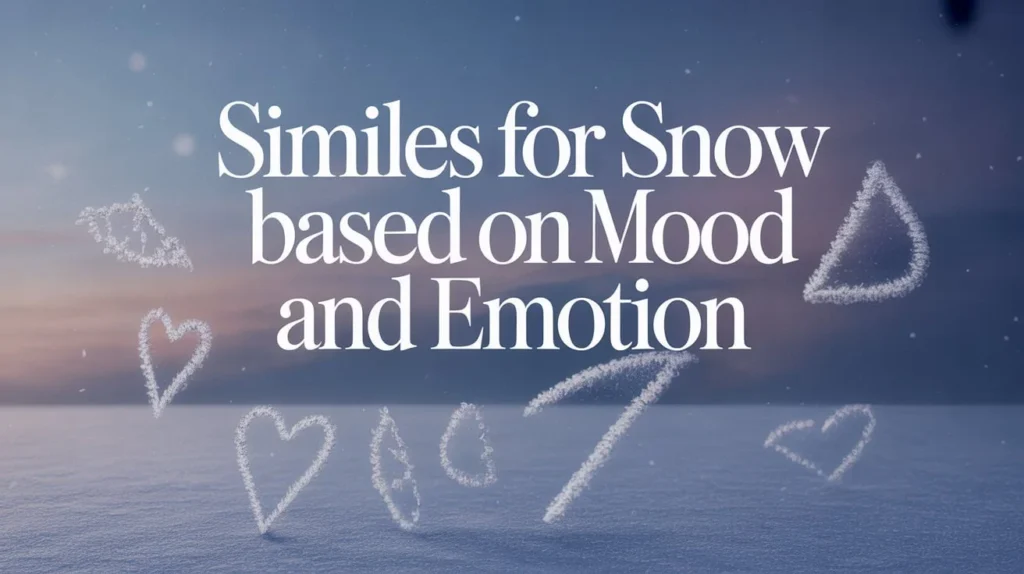
Snow isn’t always peaceful — sometimes it’s harsh, blinding, or even lonely. Below are categorized similes that match different emotional tones.
1. Romantic and Peaceful Similes
- Snow fell like a soft dream upon the rooftops.
- As calm as the hush before dawn.
- The flakes drifted like kisses from the clouds.
2. Harsh and Cold Similes
- The snow stung like shards of glass in the wind.
- As bitter as frost on bare skin.
- Snow swirled like angry ghosts around the streetlights.
3. Lonely or Melancholic Similes
- Snow lay on the ground like forgotten letters.
- As quiet as a heart that’s stopped hoping.
- Snow fell like time — slow, cold, and unrelenting.
4. Magical and Dreamy Similes
- Snowflakes twirled like tiny fairies in the air.
- The snow shimmered like a galaxy at her feet.
- As enchanting as starlight woven into silk.
Each emotional tone lets writers choose the perfect simile to match their desired mood.
Similes for Snow in Poetry and Storytelling
When crafting poems or prose, you can use snow similes to set the atmosphere, reveal emotions, or symbolize transitions.
Here’s how different types of writers can use them:
Type of WriterExample UsePoet“Snow fell like forgiveness, soft and slow.” (emotional tone)Fiction Writer“The village slept under a blanket of snow, quiet as eternity.”Student“The snow was as white as paper, waiting to be written on.”Content Creator“Life sometimes feels like snow — beautiful but fleeting.”
Similes for Snow in Everyday Speech
Even in casual language, similes for snow add richness and style. For instance:
- “It’s as white as snow in here!”
- “Her dress was as sparkly as fresh snow.”
- “He looked pale as snow when he heard the news.”
These can be used in dialogue, essays, or creative captions for social media to evoke vivid visuals.
Comparing Similes and Metaphors for Snow
It’s worth noting the difference between similes and metaphors, as both are often used interchangeably but serve distinct purposes.
ElementSimileMetaphorDefinitionComparison using “like” or “as”Direct comparison without using “like” or “as”Example“The snow was like a silver blanket.”“The snow was a silver blanket.”ToneGentle and imaginativeBold and assertiveUse CaseDescriptive, illustrativeSymbolic, emotional
So, when you say, “The snow is like a mirror,” you use a simile — but when you say, “The snow is a mirror,” you use a metaphor.
How to Write Your Own Similes for Snow
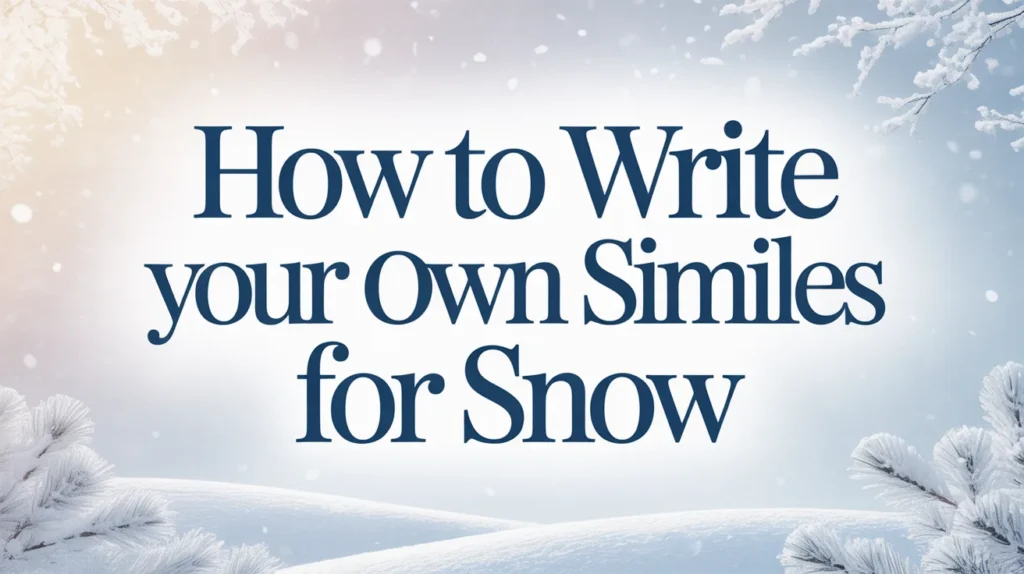
Creating your own snow similes isn’t difficult — it’s about observation and creativity. Here’s a step-by-step guide:
Step 1: Identify the Snow’s Quality
Is it soft, wet, blinding, or sparkling?
Step 2: Find a Comparison
What else in the world feels or looks like that? Feathers, silk, glass, ashes?
Step 3: Use “Like” or “As”
Combine the two elements naturally.
Example Process:
- Quality → Soft and gentle
- Comparison → Feathers
- Result → “Snow fell like feathers.”
Tips for Writing Better Similes
- Keep it simple and relatable.
- Avoid overused phrases (like “white as snow”).
- Use sensory details — sight, sound, touch.
- Match the simile with the emotion of your scene.
Unique Similes for Snow in Different Contexts
Here are some similes categorized by context for easy inspiration.
ContextSimilesNature WritingSnow blanketed the earth like a silken shroud.Romantic ScenesSnowflakes danced like lovers beneath the lamplight.Mystery or HorrorThe snow glowed like bones under moonlight.Children’s StoriesSnow fell like sugar sprinkles on a cupcake world.Inspirational WritingSnow melted like fear giving way to hope.
This flexibility is what makes snow such a versatile literary symbol.
Practical Uses for “Similes for Snow” in SEO and Content Writing
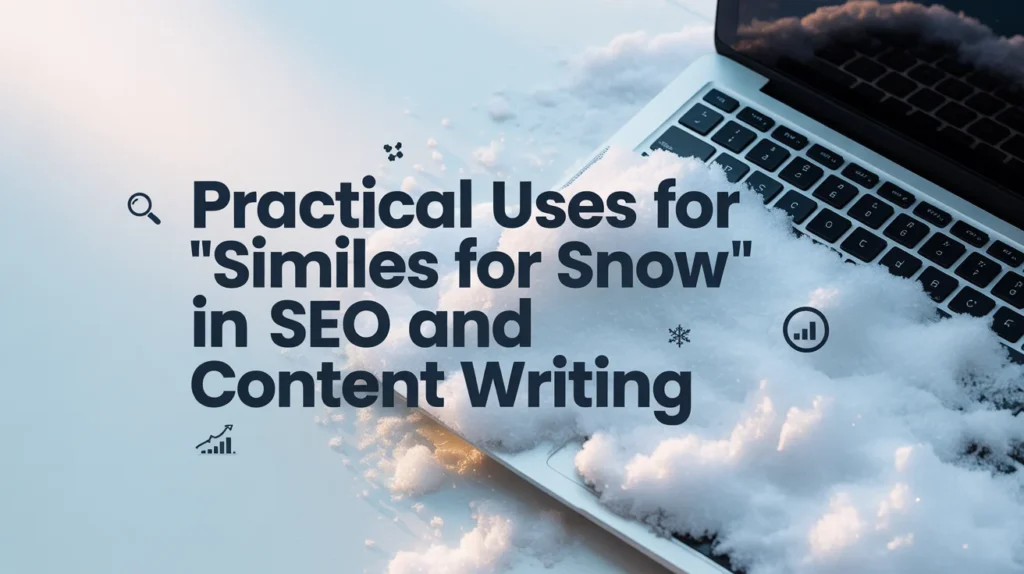
If you’re a content creator, blogger, or teacher, using similes for snow can increase reader engagement and search visibility. Here’s how:
- For Blog Posts: Add them in winter or Christmas-themed articles to make descriptions lively.
- For Education Sites: Use examples to explain literary devices in English learning content.
- For Creative Projects: Use unique similes for snow in captions, poetry blogs, or story prompts.
Internal Linking Tip: You can link this topic to related pages like:
- “Metaphors for Winter”
- “Descriptive Writing Examples”
- “Imagery in Poetry Explained”
This boosts both SEO ranking and reader value.
FAQs
Q1. What are the best similes to describe falling snow? The best similes for falling snow include “like feathers from the sky,” “as gentle as a sigh,” and “like silver dust drifting through the air.” They convey grace, softness, and tranquility.
Q2. How do similes enhance descriptions of snow in writing? Similes make writing more vivid and emotional by connecting snow’s visual or sensory qualities to familiar images. This helps readers see and feel the snow.
Q3. Can I use snow similes in academic writing? Yes, but selectively. In literature or creative essays, snow similes add beauty and depth. However, avoid them in strictly formal or technical papers.
Q4. What are some unique, modern similes for snow? Try fresh ones like “Snow glistened like phone screens in the dark” or “Snow fell like confetti at the world’s quietest party.” These bring contemporary flavor to classic imagery.
Q5. Are there negative or dark similes for snow? Absolutely. Snow can symbolize isolation or danger too — like “Snow fell like ashes of forgotten dreams” or “The snow was as cruel as a silent lie.”
Conclusion
Similes for snow open a window into imagination — turning a simple weather event into a canvas of emotions. From “snow like feathers” to “as cruel as frost,” every comparison captures a different side of winter’s character.
Whether you’re writing a poem, a novel, or a blog post, similes allow you to paint with words — to show not just how snow looks, but how it feels.
So the next time snow falls, don’t just say it’s white or cold. Say it’s “like a whisper from heaven,” or “as silent as a memory.” Because in the language of similes, snow becomes eternal.

David Langford is a language expert and grammar enthusiast with over 10 years of teaching experience. He specializes in simplifying complex grammar rules and helping writers express ideas with clarity. At GrammerPro, David shares practical guides for mastering English usage.

